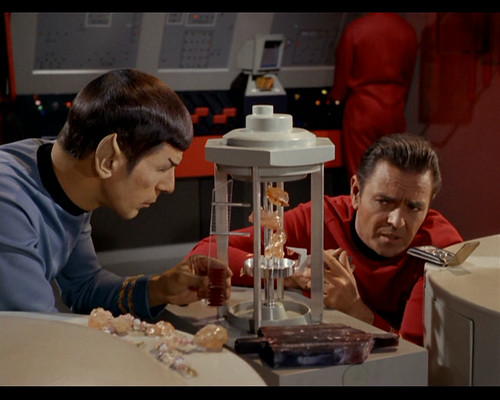There has got to be a way to get a DVD distribution deal with CBS/Paramount.
-
Welcome! The TrekBBS is the number one place to chat about Star Trek with like-minded fans.
If you are not already a member then please register an account and join in the discussion!
You are using an out of date browser. It may not display this or other websites correctly.
You should upgrade or use an alternative browser.
You should upgrade or use an alternative browser.
Props Re-used
- Thread starter Neroon
- Start date
- Status
- Not open for further replies.
Folks probably know that I spend most of my time collecting props that are going to be used aboard the Enterprise. I get coffee pots, and engineering equipment, and data card/discs and laser scalpels and stuff like that--mostly because I know we're going to be using them at some point. I don't really spend too much time collecting alien prop doohickeys. I mean, there are some really nice reproductions of those glowing, numbered necklace things the androids wore in "I, Mudd." But what would I do with them? I'd rather spend my money on something that is more likely to be needed.
Nevertheless, once in while something comes along that's just too good to pass up.
Folks might remember that in the very first regular production episode ("The Corbomite Maneuver"), Balok, played by Clint Howard, had a waist-high device from which he could control all the functioning of his ship the Fesarius. He could even order tranya from the ship's food synthisizers. This pedestal-like device had three primary-colored lights in it: red, green, and blue. Here's a shot of it next to Balok on his recliner:
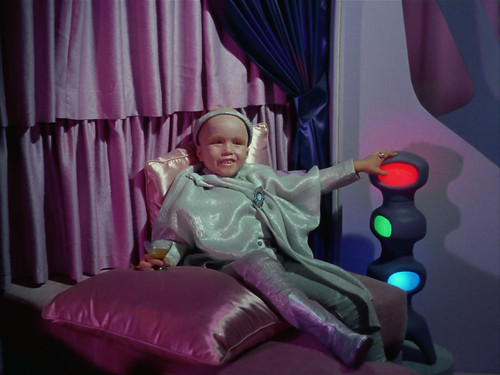
So, here's my reproduction of it:

In fact, this is a "screen used" reproduction. So how was it "screen used" if it's just a reproduction? Well, folks might remember a few years back when Comedy Central did a "roast" of William Shatner. Duing that show, one of the little comedy bits was Clint Howard (now forty years older, of course), dressed up as Balok on his recliner with this red-green-blue control device next to him--making snarky remarks about Shatner This prop I have is that very prop used in that Comedy Central routine.
And actually, this could well be something we might see on board the Enterprise at some point. Sharp-eyed viewers will note that this control device thing actually showed up a second time in TOS: it can be seen in the laboratory way over at screen right in "Operation: Annihilate" sitting on the countertop, back in the shadows. Perhaps it's in the lab because this alien technology from Balok's First Federation is being studied. Or perhaps in our exchange program with the First Federation, technology transfer and exchange has already begun taking place. Either way, this prop is kind of neat because it acts as kind of a bookend: it's in the first regular production episode of the First Season and in the last production episode of the First Season, too.

(I could have sworn I saw this thing another time, too. But I'll be damned if I can find it now. If anyone notices it as you view any episodes, please let me know.)
Nevertheless, once in while something comes along that's just too good to pass up.
Folks might remember that in the very first regular production episode ("The Corbomite Maneuver"), Balok, played by Clint Howard, had a waist-high device from which he could control all the functioning of his ship the Fesarius. He could even order tranya from the ship's food synthisizers. This pedestal-like device had three primary-colored lights in it: red, green, and blue. Here's a shot of it next to Balok on his recliner:

So, here's my reproduction of it:

In fact, this is a "screen used" reproduction. So how was it "screen used" if it's just a reproduction? Well, folks might remember a few years back when Comedy Central did a "roast" of William Shatner. Duing that show, one of the little comedy bits was Clint Howard (now forty years older, of course), dressed up as Balok on his recliner with this red-green-blue control device next to him--making snarky remarks about Shatner This prop I have is that very prop used in that Comedy Central routine.
And actually, this could well be something we might see on board the Enterprise at some point. Sharp-eyed viewers will note that this control device thing actually showed up a second time in TOS: it can be seen in the laboratory way over at screen right in "Operation: Annihilate" sitting on the countertop, back in the shadows. Perhaps it's in the lab because this alien technology from Balok's First Federation is being studied. Or perhaps in our exchange program with the First Federation, technology transfer and exchange has already begun taking place. Either way, this prop is kind of neat because it acts as kind of a bookend: it's in the first regular production episode of the First Season and in the last production episode of the First Season, too.

(I could have sworn I saw this thing another time, too. But I'll be damned if I can find it now. If anyone notices it as you view any episodes, please let me know.)
This guy has quite a few props, maybe he has some prop insights. Here is a link to his site:
http://www.startrekpropcollector.com/
http://www.startrekpropcollector.com/
The best reuse is from one series to another. The golden sash Kor and Kang wore was also Worf's Klingon sash in the first season of TNG! -- RR
Props
OMG Greg-I just found your Farpoint Videos
How fun!
http://www.youtube.com/watch?v=xu5_mmwLz2w&feature=related
There's a bust of a helmeted head that appears in three episodes. It can be seen in Dr. Adams' office in "Dagger of the Mind", in Marla McGivers' quarters in "Space Seed", and then in Spock's quarters in "Amok Time".
Here's the explanation: after Adams died, a lot of his personal artifacts went up for auction on the Enterprise. Marla McGivers liked the helmet and bought it. After she was sent into exile with Khan, she had no need of such decorative items on a harsh planet where survival equipment would be priority. Spock saw the helmet statue as she was cleaning out her cabin, thought it was cool, and asked her for it. Sure, McGivers said, I'm only gonna throw it out anyway. So Spock took it for his own quarters, and that's the story of the odyssey of this sculpture.
The "helmeted head" statue:
In "Dagger of the Mind:"

In "Space Seed:"

In "Amok Time:"

In "Mirror, Mirror:"

Greg Schnitzer
Star Trek Phase II
OMG Greg-I just found your Farpoint Videos
How fun!
http://www.youtube.com/watch?v=xu5_mmwLz2w&feature=related
Re: Props
Oh dear God. Tell *no one* about those damn things!
OMG Greg-I just found your Farpoint Videos
How fun!
http://www.youtube.com/watch?v=xu5_mmwLz2w&feature=related
Oh dear God. Tell *no one* about those damn things!
Re: Props
I can't believe you told that girl to put the damned marble back in!
Oh dear God. Tell *no one* about those damn things!
I can't believe you told that girl to put the damned marble back in!
Re: Props
Well, I was sort of oblivious to being taped, so I was performing for my local audience, not for the camera. And the abient sound, notably from the damn rattling ball, is rather annoying. Overall, the production values leave something to be desired. Mostly it's hard to entertain a room full of people from age 8 to 80 with a handful of crappy '60s kitsch. But a good time was had by all--that's the important thing.
Oh dear God. Tell *no one* about those damn things!
I can't believe you told that girl to put the damned marble back in!
Well, I was sort of oblivious to being taped, so I was performing for my local audience, not for the camera. And the abient sound, notably from the damn rattling ball, is rather annoying. Overall, the production values leave something to be desired. Mostly it's hard to entertain a room full of people from age 8 to 80 with a handful of crappy '60s kitsch. But a good time was had by all--that's the important thing.
Re: Props
You regret giving that marble its own mic, don't you.
You're talking to a ST con panel veteran here.
(But only ever "panels", not "panals".)
And the abient sound, notably from the damn rattling ball, is rather annoying.
You regret giving that marble its own mic, don't you.

Mostly it's hard to entertain a room full of people from age 8 to 80.
You're talking to a ST con panel veteran here.
(But only ever "panels", not "panals".)

The Romulan cloaking device in "The Enterprise Incident" is Nomad from "The Changeling," with a few alterations. I always loved that!
I didn't know that....thanks....

I'm reanimating this thread....
There is a large desktop device we’ve seen from time to time on Star Trek. Its first appearance is in the episode “Miri.” Dr. McCoy indicates:
“Beam down a biocomputer and a portable electronic microscope. If I'm dealing with viruses, I'll need better equipment than I have here.”
Captain Kirk reiterates this in his log:
“Captain's Log. Doctor McCoy's biocomputer and a portable electronic microscope have been beamed down from the Enterprise. They will be used in conjunction with computer banks on-board ship.”
So, this thing is (or at least it started out as) a “biocomputer.” In building this prop, it needed to be a portable, beam-down-able device and it needed to handle tissue samples somehow—so that it would look “bio-y.” Of course, it clearly needed to look “computer-y,” too.
Here’s a shot of the device from “Miri:”

It has a look similar to the bridge instrumentation: a dark gray color against which you can see the black Plexiglas faceplates. Like most of Matt Jefferies’ designs, the biocomputer design is big on angles and not so big on curves. It has an angled front and flat top. The black face has ten push buttons and ten corresponding red lights on the angled front. The buttons are labeled from 0 to 9 from left to right. Each button, when depressed, activates the corresponding red light above it. Also on the top of this unit is a large white button with a black bezel--the same style button that we see on the captain’s chair and at each of the intercom stations. The white button activates four lights on the top that have a rotating chase pattern. The lights are red, yellow, white and green.
You can see the white button and the four colored lights in the second appearance of the device—in “Tomorrow Is Yesterday:”

(In “Tomorrow Is Yesterday,” the prop seems to be functioning not as a Biocomputer. Captain Kirk says:
“Maintenance note: My recording computer has a serious malfunction. Recommend it either be corrected...or scrapped.”
So this could well be a “recording computer” (or perhaps this is just some kind of computer terminal that allows the “recording computer” to be accessed).
Way over at the right side, there a data tape card slot which handles the standard data tape card things.
For its first two appearances (in “Miri” and “Tomorrow Is Yesterday”), there’s a small red button next to a glossy black hemisphere. If the button and hemisphere had any kind of functions, it’s not obvious what they might have been.
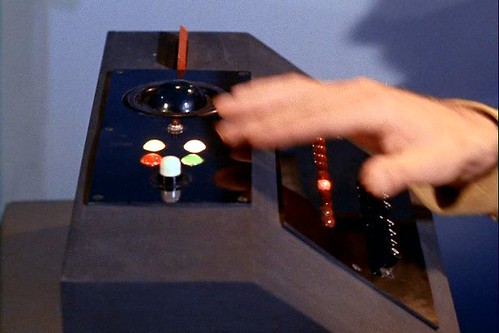
However, the black hemisphere was replaced with a flashing light—controlled by the little red button. You can barely make it out in “Devil in the Dark” (where the device also got a new light blue-gray paint job):
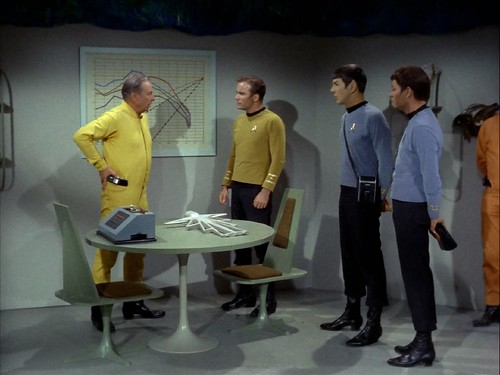
This new flashing light functionality was revealed in “Operation—Annihilate!” This is the light that blinks in Kirk’s face, causing him to realize that it is light that the creatures on Deneva can’t handle.
This large bulb on the top is a bit interesting. It’s a little hard to see, but the large main bulb seems to be sitting in a cup-like depression that has a blue-greenish fluted/scalloped edge.

This same blue-green fluted/scalloped edge glass fixture with a bulb in the center has another appearance in Star Trek: it is the light beam generator from the “Neural Neutralizer” in “Dagger of the Mind:”
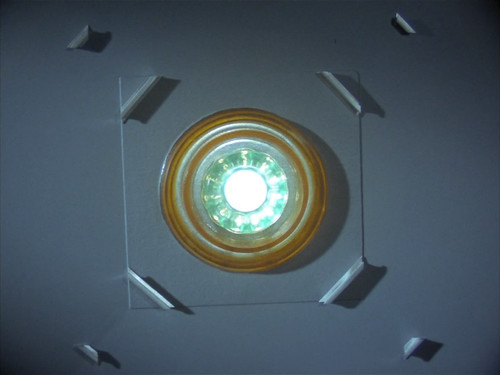
This prop has a hole at the bottom of one side—a rectangular hole with a thumb notch at the top of the opening. What’s not immediately obvious is that hole is used to slide Petri dishes in and out. Presumably, some kind of analysis is done on biological specimens.
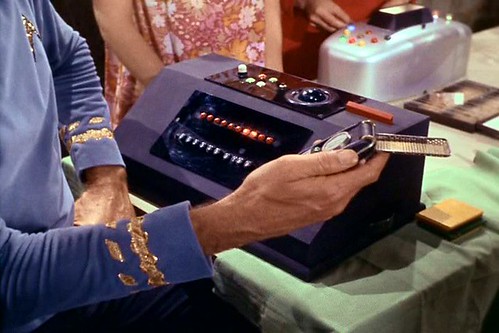
(It’s a little dark, but you can make out the Petri dish sitting in this little receptacle area a little bit better if you reduce the contrast a bit.)
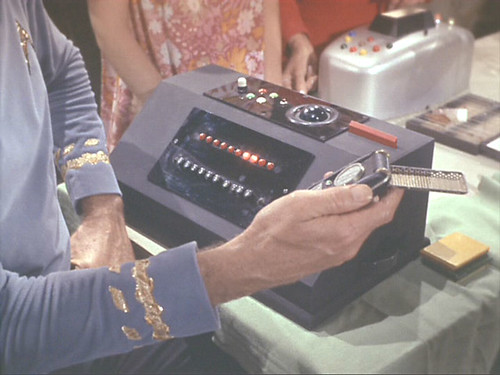
In later appearances, the set decorator would just use this area for storage of data card tape things. You can spot them from time to time in other later appearances of the prop:
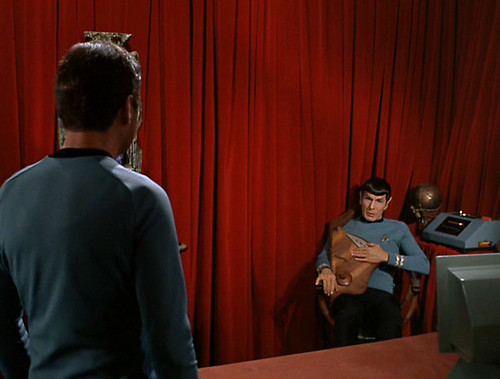
The last bit of functionality is the series of ten push buttons on the front. When one button is depressed and locks down into place, the corresponding red light above it illuminates. All the buttons are interlocked (through the miracle of old jukebox switches), so that when a new button is pushed, the old one pops back out.
This Biocomputer (and/or Recording Computer) prop appeared in a number of episodes—often in Dr. McCoy’s lab:
Episode 12: “Miri:”

Episode 21: “Tomorrow is Yesterday:”

Episode 26: “Devil in the Dark” (in the mining office):

Episode 29: “Operation--Annihilate!:”
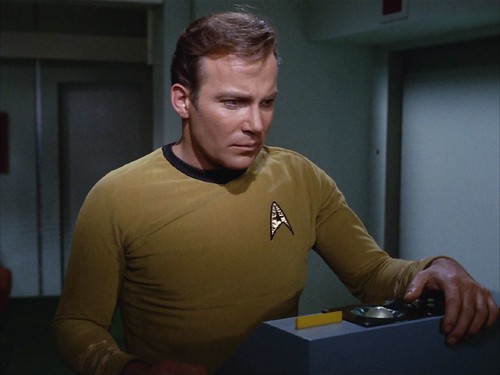
Episode 37: “The Changeling:”
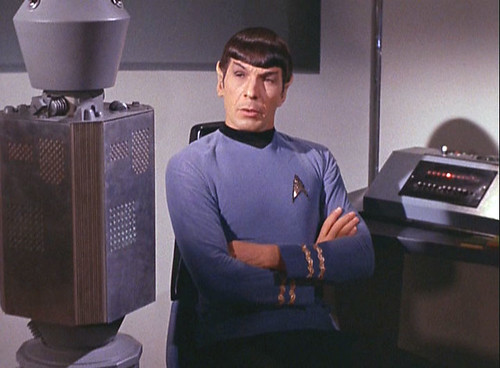
Episode 40: “The Deadly Years:”
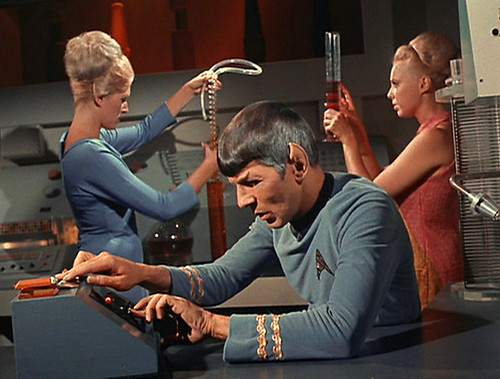
Episode 42: “The Trouble With Tribbles:”
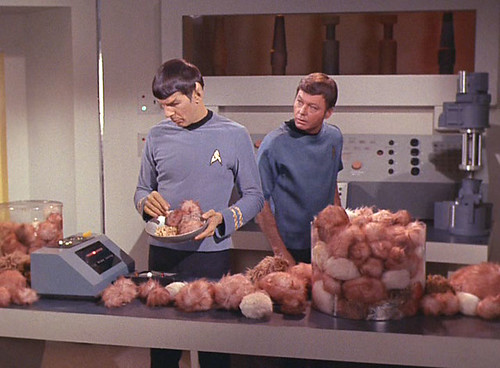
Episode 44: “Journey to Babel:”
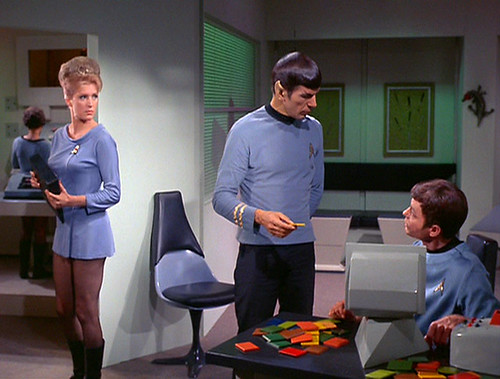
Episode 47: “Obsession:”
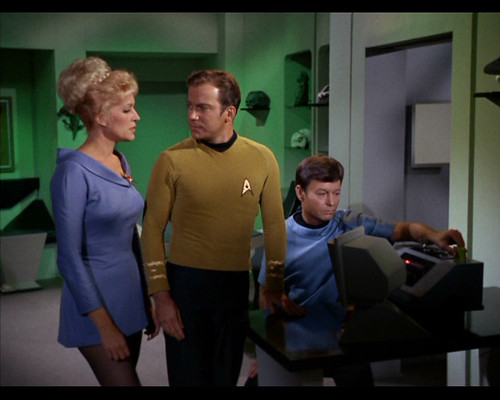
Episode 48: “The Immunity Syndrome:”
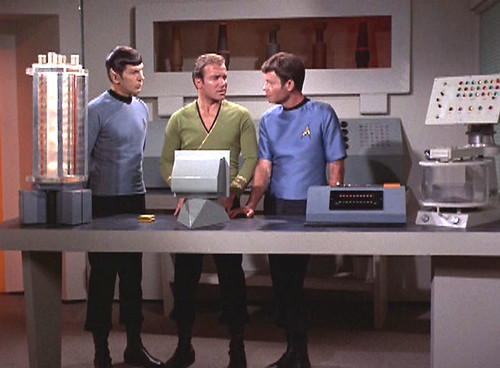
Episode 50: “By Any Other Name:”
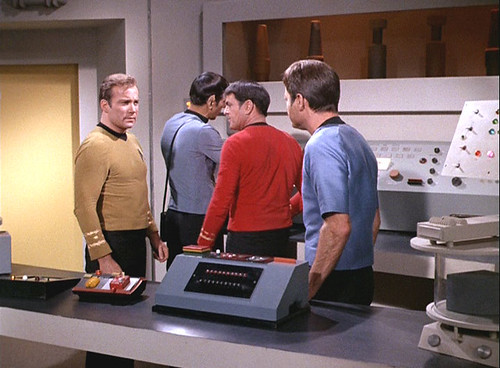
Episode 51: “Return to Tomorrow:”
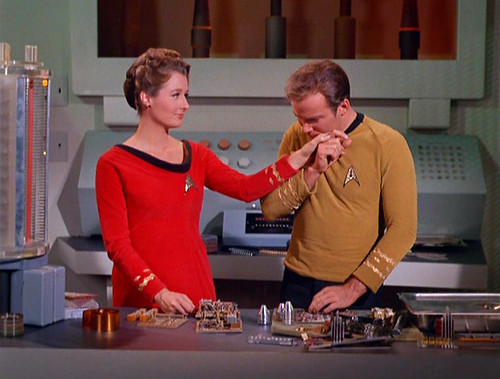
Episode 54: “The Omega Glory:”
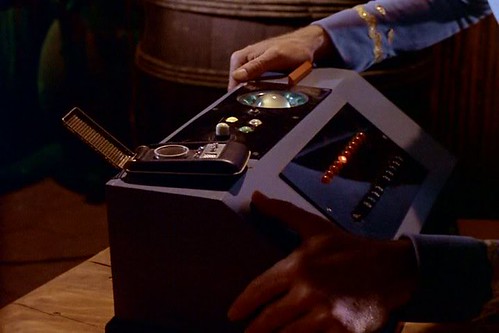
Episode 58: “The Paradise Syndrome:”

Episode 57: “Elaan of Troyius” (hiding behind Dr. McCoy):

Episode 62:” Is There In Truth No Beauty?:”
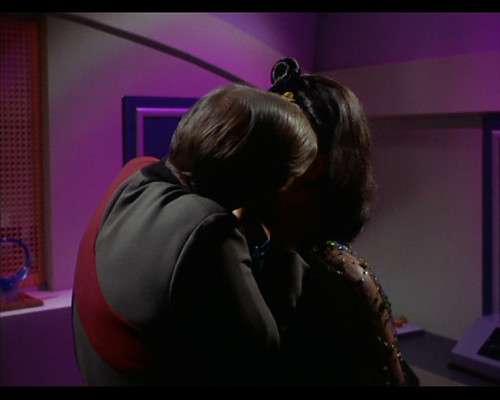
Episode 64: “The Tholian Web:”
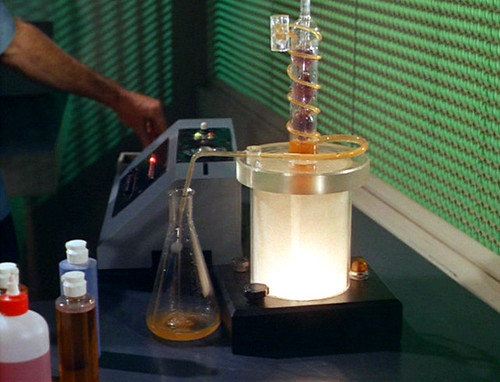
Episode 68: "Wink of an Eye:"
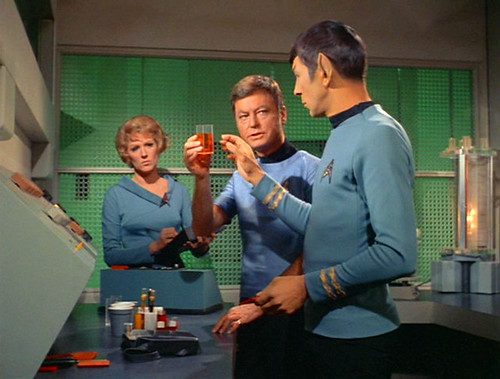
Episode 79: “Turnabout Intruder:”

In April 1977, the old magazine Star Trek Giant Poster Book, Voyage Eight had an article entitled "The Medical Technology of Star Trek" written by Geoffrey Mandel where he refers to this computer as the "Cat’s Brain" computer.

Although the biocomputer was called a "cat's brain" computer in this old magazine, the "cat's brain" moniker for the thing can be originally attributed to Mr. James Blish who adapted "Miri" into a short story for the first novelization of Star Trek episodes (first published back in January, 1967).
At any rate, here are some shots of my Biocomputer/Recording Computer reproduction:
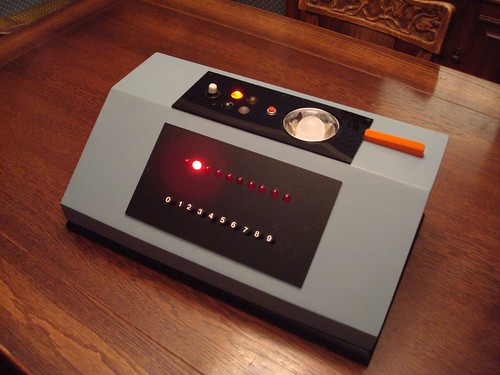
Chasing lights:

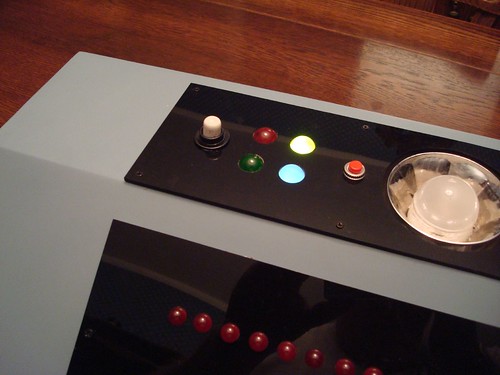
The “Hey, maybe light will affect the parasites” light:
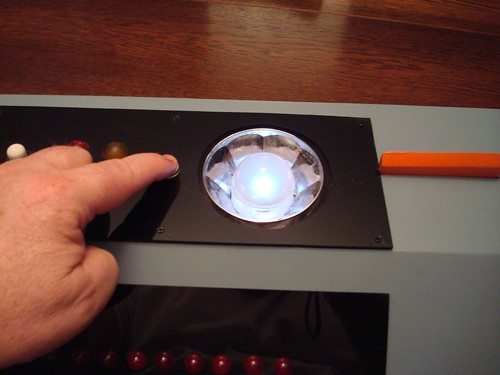
Data card tape thing:
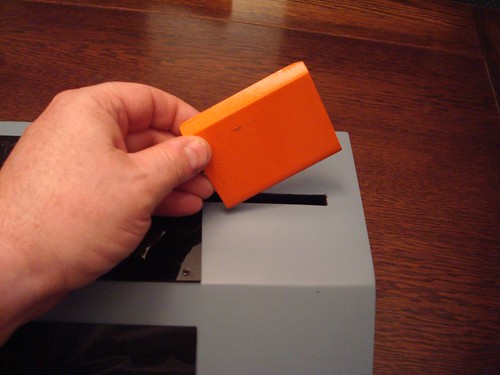
Buttons push down and light up the red lights:
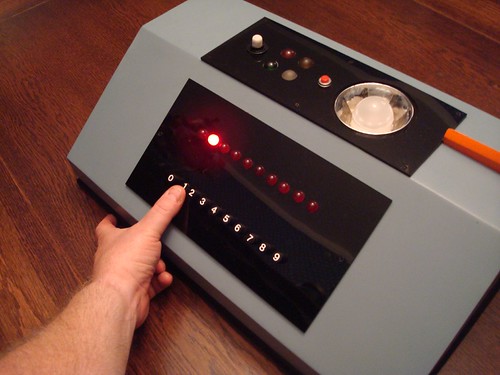
Push down another one and the old one pops back out:
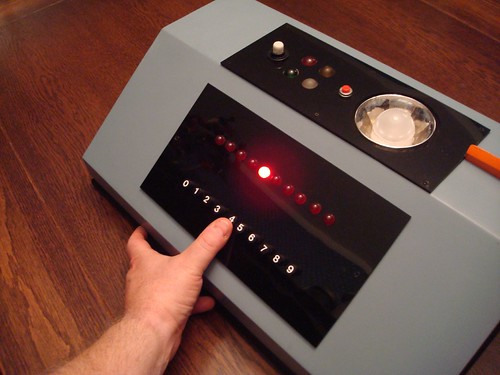
Slot in the side to receive a Petri dish. (I still need to get a Petri dish.)
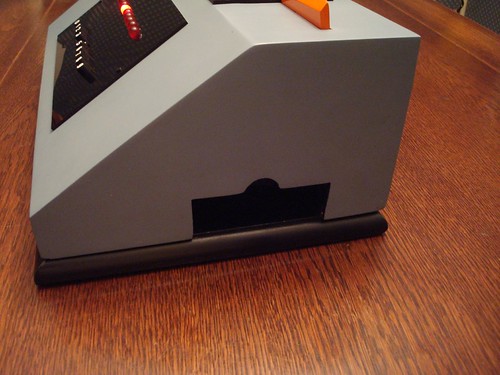
Creepy ultraviolet light comes on when something is inserted into the slot. (This wasn’t really shown, but it’s kind of a fun idea.)
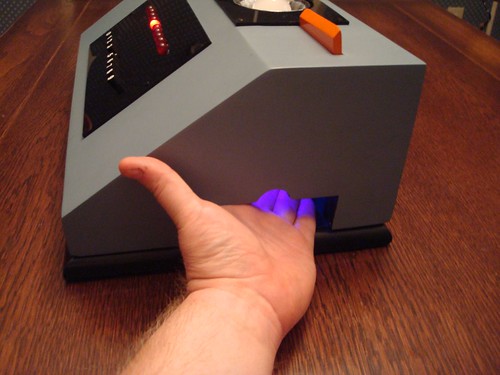
Questions and comments are always welcome.
There is a large desktop device we’ve seen from time to time on Star Trek. Its first appearance is in the episode “Miri.” Dr. McCoy indicates:
“Beam down a biocomputer and a portable electronic microscope. If I'm dealing with viruses, I'll need better equipment than I have here.”
Captain Kirk reiterates this in his log:
“Captain's Log. Doctor McCoy's biocomputer and a portable electronic microscope have been beamed down from the Enterprise. They will be used in conjunction with computer banks on-board ship.”
So, this thing is (or at least it started out as) a “biocomputer.” In building this prop, it needed to be a portable, beam-down-able device and it needed to handle tissue samples somehow—so that it would look “bio-y.” Of course, it clearly needed to look “computer-y,” too.
Here’s a shot of the device from “Miri:”

It has a look similar to the bridge instrumentation: a dark gray color against which you can see the black Plexiglas faceplates. Like most of Matt Jefferies’ designs, the biocomputer design is big on angles and not so big on curves. It has an angled front and flat top. The black face has ten push buttons and ten corresponding red lights on the angled front. The buttons are labeled from 0 to 9 from left to right. Each button, when depressed, activates the corresponding red light above it. Also on the top of this unit is a large white button with a black bezel--the same style button that we see on the captain’s chair and at each of the intercom stations. The white button activates four lights on the top that have a rotating chase pattern. The lights are red, yellow, white and green.
You can see the white button and the four colored lights in the second appearance of the device—in “Tomorrow Is Yesterday:”

(In “Tomorrow Is Yesterday,” the prop seems to be functioning not as a Biocomputer. Captain Kirk says:
“Maintenance note: My recording computer has a serious malfunction. Recommend it either be corrected...or scrapped.”
So this could well be a “recording computer” (or perhaps this is just some kind of computer terminal that allows the “recording computer” to be accessed).
Way over at the right side, there a data tape card slot which handles the standard data tape card things.
For its first two appearances (in “Miri” and “Tomorrow Is Yesterday”), there’s a small red button next to a glossy black hemisphere. If the button and hemisphere had any kind of functions, it’s not obvious what they might have been.

However, the black hemisphere was replaced with a flashing light—controlled by the little red button. You can barely make it out in “Devil in the Dark” (where the device also got a new light blue-gray paint job):

This new flashing light functionality was revealed in “Operation—Annihilate!” This is the light that blinks in Kirk’s face, causing him to realize that it is light that the creatures on Deneva can’t handle.
This large bulb on the top is a bit interesting. It’s a little hard to see, but the large main bulb seems to be sitting in a cup-like depression that has a blue-greenish fluted/scalloped edge.

This same blue-green fluted/scalloped edge glass fixture with a bulb in the center has another appearance in Star Trek: it is the light beam generator from the “Neural Neutralizer” in “Dagger of the Mind:”

This prop has a hole at the bottom of one side—a rectangular hole with a thumb notch at the top of the opening. What’s not immediately obvious is that hole is used to slide Petri dishes in and out. Presumably, some kind of analysis is done on biological specimens.

(It’s a little dark, but you can make out the Petri dish sitting in this little receptacle area a little bit better if you reduce the contrast a bit.)

In later appearances, the set decorator would just use this area for storage of data card tape things. You can spot them from time to time in other later appearances of the prop:

The last bit of functionality is the series of ten push buttons on the front. When one button is depressed and locks down into place, the corresponding red light above it illuminates. All the buttons are interlocked (through the miracle of old jukebox switches), so that when a new button is pushed, the old one pops back out.
This Biocomputer (and/or Recording Computer) prop appeared in a number of episodes—often in Dr. McCoy’s lab:
Episode 12: “Miri:”

Episode 21: “Tomorrow is Yesterday:”

Episode 26: “Devil in the Dark” (in the mining office):

Episode 29: “Operation--Annihilate!:”

Episode 37: “The Changeling:”

Episode 40: “The Deadly Years:”

Episode 42: “The Trouble With Tribbles:”

Episode 44: “Journey to Babel:”

Episode 47: “Obsession:”

Episode 48: “The Immunity Syndrome:”

Episode 50: “By Any Other Name:”

Episode 51: “Return to Tomorrow:”

Episode 54: “The Omega Glory:”

Episode 58: “The Paradise Syndrome:”

Episode 57: “Elaan of Troyius” (hiding behind Dr. McCoy):

Episode 62:” Is There In Truth No Beauty?:”

Episode 64: “The Tholian Web:”

Episode 68: "Wink of an Eye:"

Episode 79: “Turnabout Intruder:”

In April 1977, the old magazine Star Trek Giant Poster Book, Voyage Eight had an article entitled "The Medical Technology of Star Trek" written by Geoffrey Mandel where he refers to this computer as the "Cat’s Brain" computer.

Although the biocomputer was called a "cat's brain" computer in this old magazine, the "cat's brain" moniker for the thing can be originally attributed to Mr. James Blish who adapted "Miri" into a short story for the first novelization of Star Trek episodes (first published back in January, 1967).
At any rate, here are some shots of my Biocomputer/Recording Computer reproduction:

Chasing lights:


The “Hey, maybe light will affect the parasites” light:

Data card tape thing:

Buttons push down and light up the red lights:

Push down another one and the old one pops back out:

Slot in the side to receive a Petri dish. (I still need to get a Petri dish.)

Creepy ultraviolet light comes on when something is inserted into the slot. (This wasn’t really shown, but it’s kind of a fun idea.)

Questions and comments are always welcome.
Last edited:
really good thread, keep it coming(when possible)
Re-purposing props in Star Trek: The Original Series happened fairly frequently. One of these re-purposed props was a small device Mister Spock used in the episode "That Which Survives." But let's track this prop's ancestry first.
In the pilot episode "The Cage," the Enterprise crew used an early model communicator. It had the gold flip-open antenna grid, but the body was cast in clear resin so you could see all kinds of cool electronics:

(Note for a moment, please, the large silver knob at the top with the two smaller black knobs on either side of it.)
Years later, it became necessary to create a remote control device that Dr. McCoy could use to control the brainless Mister Spock in the episode "Spock's Brain." It was decided that the old Cage-era communicators should be cannibalized to create this remote control device. The antenna grid was removed and a series of multi-colored buttons was added to the top/front of the device--and it was given a silver with gold crosshatching paint job. (You can still see that the large silver knob at the top with the two smaller black knobs on either side of it still remain on the prop.)

Later, towards the end of the third season, the prop was revised again. Some kind of small hand-held device was created for Mister Spock to use in "That Which Survives." What is this device? Well, we don't really know. The script makes no reference to it. But Spock carries it around with him through nearly the whole episode, occasionally pushing buttons on it as he goes about his tasks in the episode. Is it a calculator of some kind? Some kind of tracking device? A science device? Based on its coloring and design, it would appear to be a Starfleet device rather than an alien (Vulcan) device. But who really knows. Here are some shots of this "That Which Survives" device:



As you can see, it is just a re-use of the "Spock's Brain" remote control device. It has the same colored buttons, but now the device is painted bluish. The large silver knob at the top with the two smaller black knobs on either side of it still remain on this prop, too. However, a small white button has been added to one side.
Interestingly, however, there is still a "Spock's Brain" remote control device in the hands of Star Trek prop collector Greg Jein:

So, this "That Which Survives" prop must be a second "Spock's Brain" remote control device that was revised. That is, there must have been at least two "Spock's Brain" remote controls--one that remains in its "Spock's Brain" state even to this day and which is in the hands of a collector, and the second one that was revised to make the "That Which Survives" device. (The "That Which Survives" prop has never surfaced in the prop collecting world.)
At any rate, here is my reproduction of that "That Which Survives" calculator-or-whatever-it-is prop that Spock used throughout the episode:



We might see Spock tinkering with this thing in a future Star Trek Phase II episode.
You can find the slideshow at:
http://www.flickr.com/photos/10901121@N06/sets/72157603683998010/show/
Isn't this remote / 24th century PDA / palmtop device / whatever also used by Flint to snatch the Starship Enterprise out of orbit in "Requiem for Methuselah"? If it's not the same thing, it must be very similar, possibly using the same components.
One other ultra-low-tech "prop" appeared in two TOS eps: the rolling Sickbay bed seen in "A Private Little War" (delivering an injured Spock to Sickbay) and also when Spock was delivered again during his self-induced coma in "By Any Other Name".
This rolling bed seemed out of place in TOS, since every other "dead weight" object was ever moved using anti-gravs. It looked very conventional, in fact, very terrestrial. (And it probably would've broken the FX budget to figure out a way to make the bed levitate without wheels.)
This rolling bed seemed out of place in TOS, since every other "dead weight" object was ever moved using anti-gravs. It looked very conventional, in fact, very terrestrial. (And it probably would've broken the FX budget to figure out a way to make the bed levitate without wheels.)
...and to wheel the nearly frozen Leslie and Sulu out of the transporter room down to Sickbay right at the end of "The Enemy Within."
Yes, pretty 20th century. I'm thinking that anything else--like some elaborate anti-grav gizmo would have distracted from the drama of the scene. As commonplace as they might be to the Enterprise crew, they wouldn't be commonplace to the viewers at home in 1966-1969 and probably would have gotten the viewers to pay attention to the wrong thing in the scene.
Yes, pretty 20th century. I'm thinking that anything else--like some elaborate anti-grav gizmo would have distracted from the drama of the scene. As commonplace as they might be to the Enterprise crew, they wouldn't be commonplace to the viewers at home in 1966-1969 and probably would have gotten the viewers to pay attention to the wrong thing in the scene.
One other ultra-low-tech "prop" appeared in two TOS eps: the rolling Sickbay bed seen in "A Private Little War" (delivering an injured Spock to Sickbay) and also when Spock was delivered again during his self-induced coma in "By Any Other Name".
This rolling bed seemed out of place in TOS, since every other "dead weight" object was ever moved using anti-gravs. It looked very conventional, in fact, very terrestrial. (And it probably would've broken the FX budget to figure out a way to make the bed levitate without wheels.)
A screwdriver looks the same now as it has for the past couple hundred years. Why should a gurney necessarily be all futurized when the whole point is just to get the patient from point A to point B? Plus, what if the power unit goes out on that high-tech antigrav gurney, then where'll you be?
Nothin' wrong with standard gurneys borrowed from the Dr. Kildare set, or wherever they got them.
Nothin' wrong with standard gurneys borrowed from the Dr. Kildare set, or wherever they got them.
- Status
- Not open for further replies.
Similar threads
- Replies
- 220
- Views
- 40K
- Replies
- 4
- Views
- 3K
Contest: ENTER
February 2025 Art Challenge - Suggest Your Themes!
- Replies
- 16
- Views
- 4K
Contest: ENTER
March 2025 Art Challenge - Suggest Your Themes!
- Replies
- 2
- Views
- 3K
If you are not already a member then please register an account and join in the discussion!

